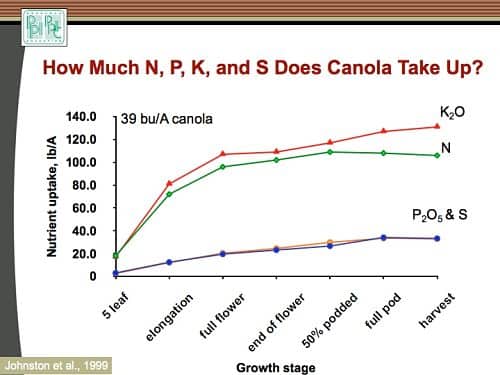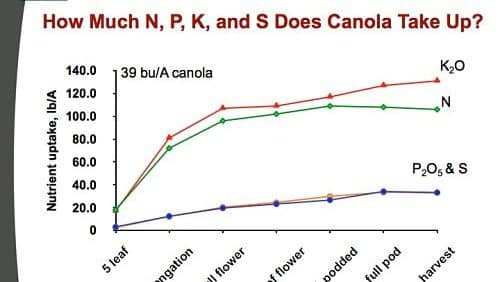
Sulphur and nitrogen deficiencies are showing up in some canola crops. The crop may not have received enough fertilizer to begin with, especially if this year’s rates did not compensate for high yields and high removal last year. Excess moisture may have added to nutrient losses.
Flowering is not an ideal time to top dress, and applications any time after early flowering may not provide an economic benefit. Late fertilizer needs to be applied to the soil surface and get a rain to move it into the root zone quickly for any chance of an economic benefit this year.
Late sulphur top up. The ideal time for a sulphur top up is any time before flowering, but a top up at early flowering may pay off if plants are showing signs of sulphur deficiency. Applications made after early flowering may only be useful for next year’s crop.
Late nitrogen top up. The ideal time for a nitrogen top up is before the 5-leaf stage of canola. This is just before peak nitrogen uptake, so a top up before this stage makes sure nitrogen is in place for when the crop needs it. But AAFC research out of Indian Head, Saskatchewan, shows that nitrogen top dress as late as 5-10% flower can still provide a yield benefit. The benefit may not be as high as an earlier application, but could still be economical. If a field is close to flowering and plants have pale lower leaves and stunted growth that could be attributed to nitrogen deficiency, then a top up may pay off. To determine the likelihood of deficiency, think about the rates put down, possible losses due to high soil moisture levels, and yield outlook for the crop. When making this assessment, consider the possibility that excess soil has stressed roots and inhibited nutrient uptake. In this case, a top up may not provide any benefit if the deficiency is due to inability to access the nutrient rather than insufficient quantities in the soil.
Will unused top dress be lost? If the crop cannot use all the nutrient applied as a late top dress, most of the S would be available for next year’s crop. The only loss situation would be leaching on a sandy textured soil with lots of rain and snowmelt. Some of the N would be available. More of it will be available if dry conditions persist the rest of this year. If there is a lot of cereal residue to cause immobilization, and if there is lots of rain and snowmelt to promote denitrification, then not much will left for next year. However, top dress rates are usually quite low compared to total applied fertilizer, so it would be hard to pick out an effect on a well fertilized crop the next year.
Further reading:
Top dress tips for N and S

